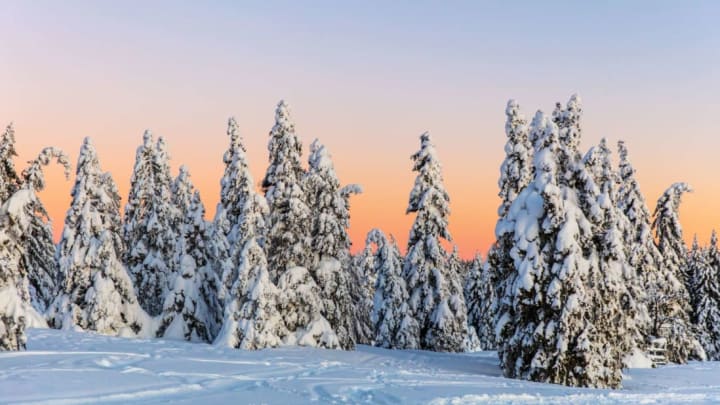There are three answers to this question: A heck of a lot, not that many, and a whole heck of a lot. Or, if you want specifics: 5, 2, and at least 99.
That’s because there is no single "Eskimo" language. Eskimo is a loose term—and often considered offensive—for the Inuit and Yupik peoples living in the polar regions of Alaska, Canada, Greenland, and Siberia. They speak a variety of languages, the most common ones being Central Alaskan Yup'ik, West Greenlandic (Kalaallisut), and Inuktitut. There are multiple dialects of each. Some have more words for snow than others.
The question of how many “Eskimo” words for snow are there has been problematic, but we’ll try to break it down.
A Heck of a Lot of “Eskimo” Words for Snow
Today, you see the "Eskimos have so many words for snow" trope everywhere, from ads to cartoons to articles about hairstyles. As Laura Martin noted in her 1986 study "Eskimo Words for Snow" [PDF] anthropologists and psychologists started using the story in the late 1950s as a go-to illustration in discussions of the relationship between language, culture, and perception. If polar peoples carved up the world of snow into four or five categories where English-speakers had one, was their perception of snow different from Westerners'? From there, the idea spread into the popular culture, and it has been going strong ever since. Where the original sources mentioned four or five specific snow words, in the hands of the public, that number turned into 25, 50, 100, 400—it didn't really matter. The trope did not exist to give information about Arctic languages, but to say, “hey, other people sure do look at the world differently!"
The idea of using language to show that other people look at the world differently has a nasty history, however. Early ethnographers used linguistic evidence to impugn the character or cognitive abilities of other peoples. An 1827 treatise on global geography mentions that in the language of Lapland, "there are five words for snow, seven or eight for a mountain, but honesty, virtue, and conscience must be expressed by a periphrasis." The academics who picked up the snow words tale in the 1950s didn't take such a simplistic view of the relationship between language and culture. But to say that having a lot of words for something means you find it important or perceive it more readily gives some people the wrong idea that not having a lot of words for something means you can't perceive it and don't find it important.
Not That Many “Eskimo” Words for Snow
Scholars have debunked that false implication in part by debunking the snow words trope. Martin's paper and Geoffrey Pullum's well-known essay "The Great Eskimo Vocabulary Hoax" [PDF] point out that the linguistic facts did not support the idea that “Eskimos” had some wildly exotic giant snow vocabulary.
The Inuit and Yupik languages are polysynthetic, meaning they combine a limited set of roots and word endings to create an unlimited set of words. For instance, from oqaq—the West Greenlandic root for tongue—you get oqaaseq (“word”), oqaasipiluuppaa (“harangues him”), oqaluppoq (“speaks”), oqaatiginerluppaa (“speaks badly about him”) and Oqaasileriffik (the Greenlandic language secretariat). These words can then be expanded with all sorts of other endings, so that a sentence like, "I hadn't planned to cause you to harangue him after all" would be expressed with one word. If these word-sentences count as words, then Inuit don't just have thousands of words for snow, but for everything.
Martin suggests that we instead ask how many roots “Eskimos” have for snow. In the case of West Greenlandic, the answer is two: qanik ("snow in the air"), and aput ("snow on the ground"). From these we can derive words like qanipalaat ("feathery clumps of falling snow") and apusiniq ("snowdrift"). There are also terms for snow that use different roots (for covering, floating, or other things snow does), but Pullum's essay notes a problem with the notion of counting words with other roots as "snow words": Do we count an Inuktitut word that can mean "snow for igloo making" as a snow word if it also just means building materials in general? To use another example, is "pack" a snow word in English, or just a general term for tightly squishing things together? In any case, there may be just as many snow words in English (sleet, slush, flurry, avalanche, etc.) as in "Eskimo" languages.
A Whole Heck of a Lot of “Eskimo” Words for Snow
The linguist K. David Harrison has traveled all over the world studying endangered languages. In his book The Last Speakers, he writes that it's a mistake to think that just because people made uninformed and exaggerated claims about “Eskimo” snow words in the past, the real number must be ordinary and uninteresting.
From what he has seen, "the number of snow/ice/wind/weather terms in some Arctic languages is impressively vast, rich, and complex," he writes; the Yupik "identify and name at least 99 distinct sea ice formations." For example, according to Watching Ice and Weather Our Way, a collaborative study between Yupik hunters and Smithsonian scholars, nuyileq means "crushed ice beginning to spread out; dangerous to walk on. The ice is dissolving, but still has not dispersed in water, although it is vulnerable for one to fall through and to sink. Sometimes seals can even surface on this ice because the water is starting to appear."
There is a lot more included in this definition than would be included in a typical dictionary, and it shows how a set of terminology can reflect specific expertise. Just as geologists have lots of words for rocks, polar peoples have many words to describe the Arctic environment and the means for surviving in it. Yup'ik ice words, whatever the number, package information in a useful way. We ignore the significance of that packaging, Harrison writes, "at our peril."
A version of this story ran in 2013; it has been updated for 2021.
